2010 Hyundai Sonata light
[x] Cancel search: lightPage 25 of 285
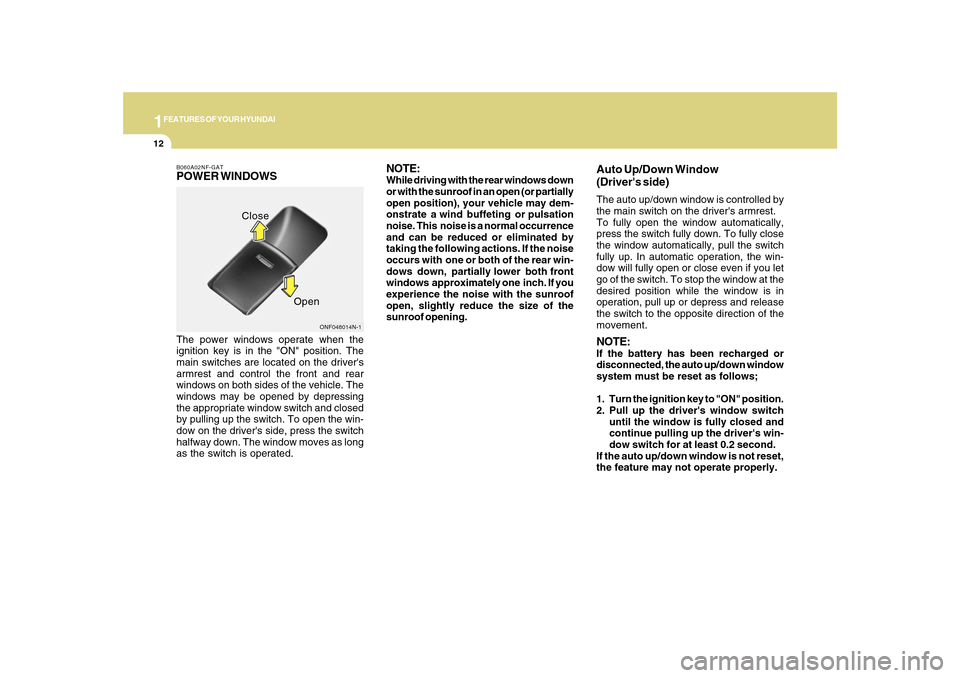
1FEATURES OF YOUR HYUNDAI12
B060A02NF-GATPOWER WINDOWSThe power windows operate when the
ignition key is in the "ON" position. The
main switches are located on the driver's
armrest and control the front and rear
windows on both sides of the vehicle. The
windows may be opened by depressing
the appropriate window switch and closed
by pulling up the switch. To open the win-
dow on the driver's side, press the switch
halfway down. The window moves as long
as the switch is operated.
ONF048014N-1
Auto Up/Down Window
(Driver's side)The auto up/down window is controlled by
the main switch on the driver's armrest.
To fully open the window automatically,
press the switch fully down. To fully close
the window automatically, pull the switch
fully up. In automatic operation, the win-
dow will fully open or close even if you let
go of the switch. To stop the window at the
desired position while the window is in
operation, pull up or depress and release
the switch to the opposite direction of the
movement.NOTE:If the battery has been recharged or
disconnected, the auto up/down window
system must be reset as follows;
1. Turn the ignition key to "ON" position.
2. Pull up the driver's window switch
until the window is fully closed and
continue pulling up the driver's win-
dow switch for at least 0.2 second.
If the auto up/down window is not reset,
the feature may not operate properly. Open Close
NOTE:While driving with the rear windows down
or with the sunroof in an open (or partially
open position), your vehicle may dem-
onstrate a wind buffeting or pulsation
noise. This noise is a normal occurrence
and can be reduced or eliminated by
taking the following actions. If the noise
occurs with one or both of the rear win-
dows down, partially lower both front
windows approximately one inch. If you
experience the noise with the sunroof
open, slightly reduce the size of the
sunroof opening.
Page 38 of 285

1
FEATURES OF YOUR HYUNDAI
25
B180A02NF-AATSEAT BELT-Driver's 3-Point System
with Emergency Locking Retractor
To Fasten Your BeltTo fasten your seat belt, pull it out of the
retractor and insert the metal tab into the
buckle. There will be an audible "click"
when the tab locks into the buckle.
The seat belt automatically adjusts to the
proper length only after the lap belt portion
is adjusted manually so that it fits snugly
around your hips. If you lean forward in a
slow, easy motion, the belt will extend and
let you move around. If there is a sudden
stop or impact, however, the belt will lock
into position. It will also lock if you try to lean
forward too quickly.
B180A01NF
NOTE:o If you are not able to pull out the seat
belt from the retractor, firmly pull the
belt out and release it. Then you will be
able to pull the belt out smoothly.
o If the driver's seat belt is not fastened
when the ignition key is turned from
the "OFF" position to the "ON" or
"START" position, the seat belt warn-
ing light will blink and the warning
chime will sound for approximately
six seconds to remind the driver to
fasten the driver's seat belt.
!
Release the button to lock the anchor into
position. Try sliding the height adjuster to
make sure that it has locked into position.
WARNING:
o Verify the shoulder belt anchor is
locked into position at the appropriate
height. Never position the shoulder
belt across your neck or face.
Improperly positioned seat belts can
cause serious injuries in an accident.
o Failure to replace seat belts after an
accident could leave you with
damaged seat belts that will not
provide protection in the event of
another collision leading to personal
injury or death. Replace your seat
belts after being in an accident as
soon as possible.
!
WARNING:
o Adjust the shoulder belt height when
you sit well back in the seat.
o When adjusting the shoulder belt
height, grip the height adjuster button
securely and slide the height adjuster
up or down.
Page 39 of 285
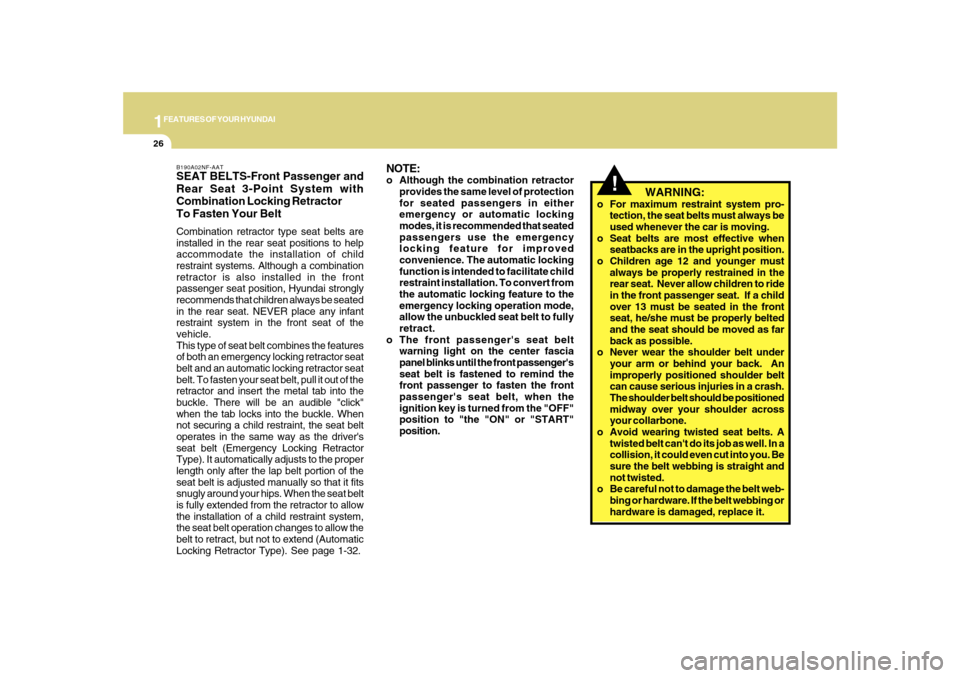
1FEATURES OF YOUR HYUNDAI26
B190A02NF-AATSEAT BELTS-Front Passenger and
Rear Seat 3-Point System with
Combination Locking Retractor
To Fasten Your BeltCombination retractor type seat belts are
installed in the rear seat positions to help
accommodate the installation of child
restraint systems. Although a combination
retractor is also installed in the front
passenger seat position, Hyundai strongly
recommends that children always be seated
in the rear seat. NEVER place any infant
restraint system in the front seat of the
vehicle.
This type of seat belt combines the features
of both an emergency locking retractor seat
belt and an automatic locking retractor seat
belt. To fasten your seat belt, pull it out of the
retractor and insert the metal tab into the
buckle. There will be an audible "click"
when the tab locks into the buckle. When
not securing a child restraint, the seat belt
operates in the same way as the driver's
seat belt (Emergency Locking Retractor
Type). It automatically adjusts to the proper
length only after the lap belt portion of the
seat belt is adjusted manually so that it fits
snugly around your hips. When the seat belt
is fully extended from the retractor to allow
the installation of a child restraint system,
the seat belt operation changes to allow the
belt to retract, but not to extend (Automatic
Locking Retractor Type). See page 1-32.
NOTE:o Although the combination retractor
provides the same level of protection
for seated passengers in either
emergency or automatic locking
modes, it is recommended that seated
passengers use the emergency
locking feature for improved
convenience. The automatic locking
function is intended to facilitate child
restraint installation. To convert from
the automatic locking feature to the
emergency locking operation mode,
allow the unbuckled seat belt to fully
retract.
o The front passenger's seat belt
warning light on the center fascia
panel blinks until the front passenger's
seat belt is fastened to remind the
front passenger to fasten the front
passenger's seat belt, when the
ignition key is turned from the "OFF"
position to "the "ON" or "START"
position.
WARNING:
o For maximum restraint system pro-
tection, the seat belts must always be
used whenever the car is moving.
o Seat belts are most effective when
seatbacks are in the upright position.
o Children age 12 and younger must
always be properly restrained in the
rear seat. Never allow children to ride
in the front passenger seat. If a child
over 13 must be seated in the front
seat, he/she must be properly belted
and the seat should be moved as far
back as possible.
o Never wear the shoulder belt under
your arm or behind your back. An
improperly positioned shoulder belt
can cause serious injuries in a crash.
The shoulder belt should be positioned
midway over your shoulder across
your collarbone.
o Avoid wearing twisted seat belts. A
twisted belt can't do its job as well. In a
collision, it could even cut into you. Be
sure the belt webbing is straight and
not twisted.
o Be careful not to damage the belt web-
bing or hardware. If the belt webbing or
hardware is damaged, replace it.
!
Page 41 of 285
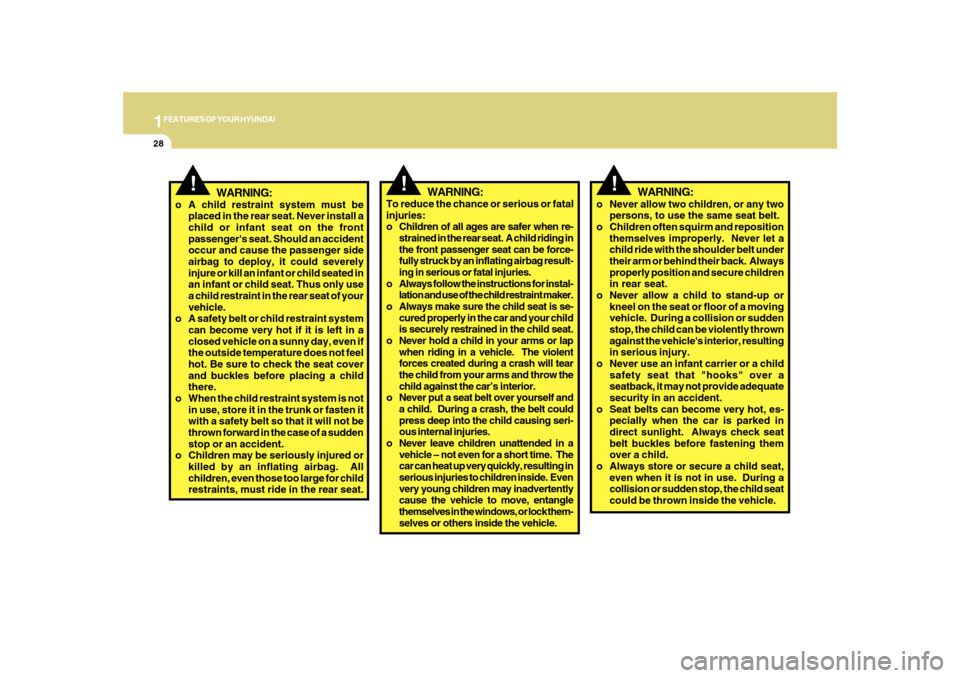
1FEATURES OF YOUR HYUNDAI28
!
WARNING:
o A child restraint system must be
placed in the rear seat. Never install a
child or infant seat on the front
passenger's seat. Should an accident
occur and cause the passenger side
airbag to deploy, it could severely
injure or kill an infant or child seated in
an infant or child seat. Thus only use
a child restraint in the rear seat of your
vehicle.
o A safety belt or child restraint system
can become very hot if it is left in a
closed vehicle on a sunny day, even if
the outside temperature does not feel
hot. Be sure to check the seat cover
and buckles before placing a child
there.
o When the child restraint system is not
in use, store it in the trunk or fasten it
with a safety belt so that it will not be
thrown forward in the case of a sudden
stop or an accident.
o Children may be seriously injured or
killed by an inflating airbag. All
children, even those too large for child
restraints, must ride in the rear seat.
!
WARNING:
To reduce the chance or serious or fatal
injuries:
o Children of all ages are safer when re-
strained in the rear seat. A child riding in
the front passenger seat can be force-
fully struck by an inflating airbag result-
ing in serious or fatal injuries.
o Always follow the instructions for instal-
lation and use of the child restraint maker.
o Always make sure the child seat is se-
cured properly in the car and your child
is securely restrained in the child seat.
o Never hold a child in your arms or lap
when riding in a vehicle. The violent
forces created during a crash will tear
the child from your arms and throw the
child against the car’s interior.
o Never put a seat belt over yourself and
a child. During a crash, the belt could
press deep into the child causing seri-
ous internal injuries.
o Never leave children unattended in a
vehicle – not even for a short time. The
car can heat up very quickly, resulting in
serious injuries to children inside. Even
very young children may inadvertently
cause the vehicle to move, entangle
themselves in the windows, or lock them-
selves or others inside the vehicle.o Never allow two children, or any two
persons, to use the same seat belt.
o Children often squirm and reposition
themselves improperly. Never let a
child ride with the shoulder belt under
their arm or behind their back. Always
properly position and secure children
in rear seat.
o Never allow a child to stand-up or
kneel on the seat or floor of a moving
vehicle. During a collision or sudden
stop, the child can be violently thrown
against the vehicle's interior, resulting
in serious injury.
o Never use an infant carrier or a child
safety seat that "hooks" over a
seatback, it may not provide adequate
security in an accident.
o Seat belts can become very hot, es-
pecially when the car is parked in
direct sunlight. Always check seat
belt buckles before fastening them
over a child.
o Always store or secure a child seat,
even when it is not in use. During a
collision or sudden stop, the child seat
could be thrown inside the vehicle.
!
WARNING:
Page 46 of 285
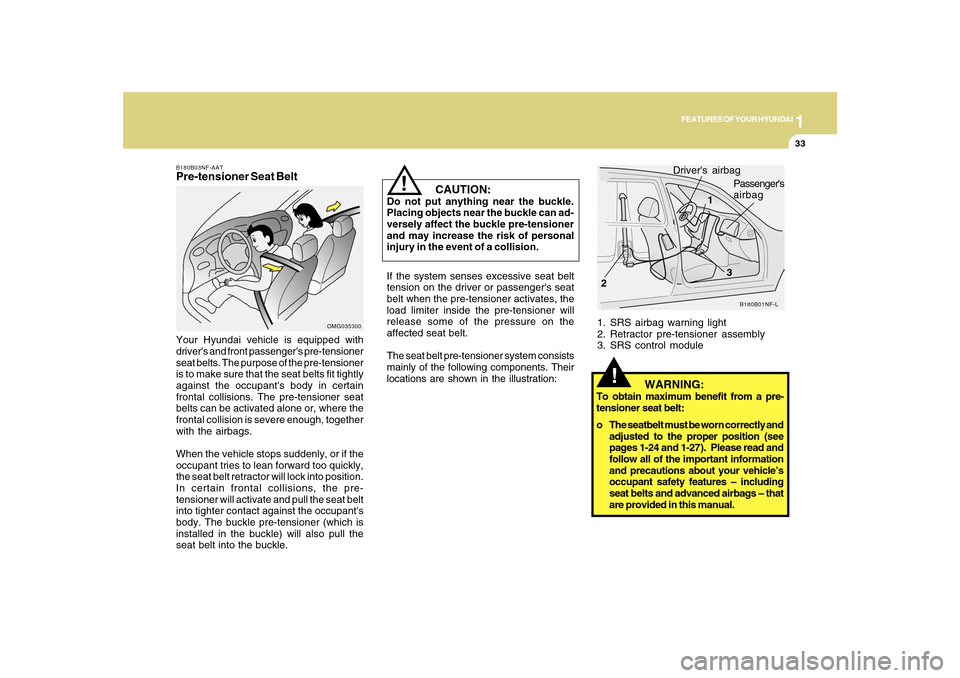
1
FEATURES OF YOUR HYUNDAI
33
!
1. SRS airbag warning light
2. Retractor pre-tensioner assembly
3. SRS control module
B180B01NF-L
1
23 Driver's airbag
Passenger's
airbag
WARNING:
To obtain maximum benefit from a pre-
tensioner seat belt:
o The seatbelt must be worn correctly and
adjusted to the proper position (see
pages 1-24 and 1-27). Please read and
follow all of the important information
and precautions about your vehicle’s
occupant safety features – including
seat belts and advanced airbags – that
are provided in this manual.
!
CAUTION:
Do not put anything near the buckle.
Placing objects near the buckle can ad-
versely affect the buckle pre-tensioner
and may increase the risk of personal
injury in the event of a collision.
If the system senses excessive seat belt
tension on the driver or passenger's seat
belt when the pre-tensioner activates, the
load limiter inside the pre-tensioner will
release some of the pressure on the
affected seat belt.
The seat belt pre-tensioner system consists
mainly of the following components. Their
locations are shown in the illustration:
B180B03NF-AATPre-tensioner Seat BeltYour Hyundai vehicle is equipped with
driver's and front passenger's pre-tensioner
seat belts. The purpose of the pre-tensioner
is to make sure that the seat belts fit tightly
against the occupant's body in certain
frontal collisions. The pre-tensioner seat
belts can be activated alone or, where the
frontal collision is severe enough, together
with the airbags.
When the vehicle stops suddenly, or if the
occupant tries to lean forward too quickly,
the seat belt retractor will lock into position.
In certain frontal collisions, the pre-
tensioner will activate and pull the seat belt
into tighter contact against the occupant's
body. The buckle pre-tensioner (which is
installed in the buckle) will also pull the
seat belt into the buckle.
OMG035300
Page 47 of 285
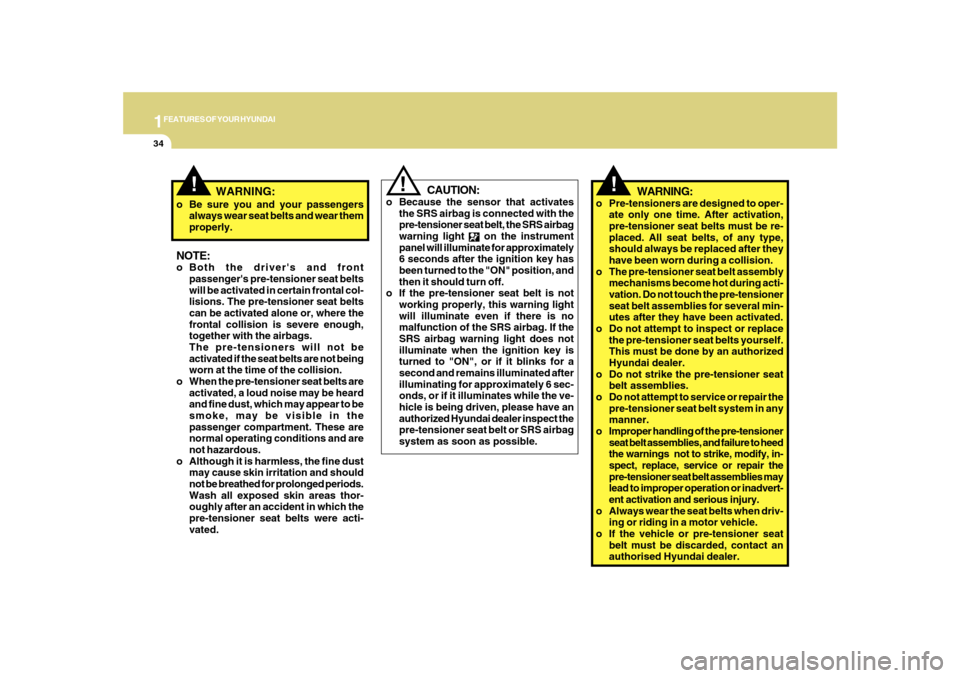
1FEATURES OF YOUR HYUNDAI34
!
o Be sure you and your passengers
always wear seat belts and wear them
properly.NOTE:o Both the driver's and front
passenger's pre-tensioner seat belts
will be activated in certain frontal col-
lisions. The pre-tensioner seat belts
can be activated alone or, where the
frontal collision is severe enough,
together with the airbags.
The pre-tensioners will not be
activated if the seat belts are not being
worn at the time of the collision.
o When the pre-tensioner seat belts are
activated, a loud noise may be heard
and fine dust, which may appear to be
smoke, may be visible in the
passenger compartment. These are
normal operating conditions and are
not hazardous.
o Although it is harmless, the fine dust
may cause skin irritation and should
not be breathed for prolonged periods.
Wash all exposed skin areas thor-
oughly after an accident in which the
pre-tensioner seat belts were acti-
vated.
WARNING:
!
CAUTION:
o Because the sensor that activates
the SRS airbag is connected with the
pre-tensioner seat belt, the SRS airbag
warning light
on the instrument
panel will illuminate for approximately
6 seconds after the ignition key has
been turned to the "ON" position, and
then it should turn off.
o If the pre-tensioner seat belt is not
working properly, this warning light
will illuminate even if there is no
malfunction of the SRS airbag. If the
SRS airbag warning light does not
illuminate when the ignition key is
turned to "ON", or if it blinks for a
second and remains illuminated after
illuminating for approximately 6 sec-
onds, or if it illuminates while the ve-
hicle is being driven, please have an
authorized Hyundai dealer inspect the
pre-tensioner seat belt or SRS airbag
system as soon as possible.
!
WARNING:
o Pre-tensioners are designed to oper-
ate only one time. After activation,
pre-tensioner seat belts must be re-
placed. All seat belts, of any type,
should always be replaced after they
have been worn during a collision.
o The pre-tensioner seat belt assembly
mechanisms become hot during acti-
vation. Do not touch the pre-tensioner
seat belt assemblies for several min-
utes after they have been activated.
o Do not attempt to inspect or replace
the pre-tensioner seat belts yourself.
This must be done by an authorized
Hyundai dealer.
o Do not strike the pre-tensioner seat
belt assemblies.
o Do not attempt to service or repair the
pre-tensioner seat belt system in any
manner.
o Improper handling of the pre-tensioner
seat belt assemblies, and failure to heed
the warnings not to strike, modify, in-
spect, replace, service or repair the
pre-tensioner seat belt assemblies may
lead to improper operation or inadvert-
ent activation and serious injury.
o Always wear the seat belts when driv-
ing or riding in a motor vehicle.
o If the vehicle or pre-tensioner seat
belt must be discarded, contact an
authorised Hyundai dealer.
Page 49 of 285
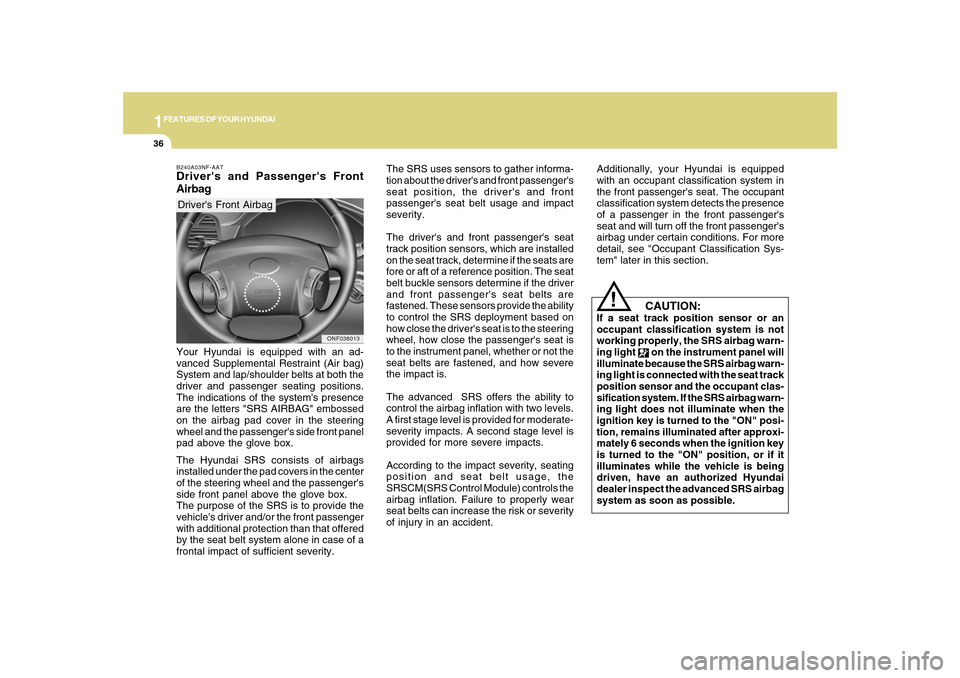
1FEATURES OF YOUR HYUNDAI36
The SRS uses sensors to gather informa-
tion about the driver's and front passenger's
seat position, the driver's and front
passenger's seat belt usage and impact
severity.
The driver's and front passenger's seat
track position sensors, which are installed
on the seat track, determine if the seats are
fore or aft of a reference position. The seat
belt buckle sensors determine if the driver
and front passenger's seat belts are
fastened. These sensors provide the ability
to control the SRS deployment based on
how close the driver's seat is to the steering
wheel, how close the passenger's seat is
to the instrument panel, whether or not the
seat belts are fastened, and how severe
the impact is.
The advanced SRS offers the ability to
control the airbag inflation with two levels.
A first stage level is provided for moderate-
severity impacts. A second stage level is
provided for more severe impacts.
According to the impact severity, seating
position and seat belt usage, the
SRSCM(SRS Control Module) controls the
airbag inflation. Failure to properly wear
seat belts can increase the risk or severity
of injury in an accident.
CAUTION:
If a seat track position sensor or an
occupant classification system is not
working properly, the SRS airbag warn-
ing light
on the instrument panel will
illuminate because the SRS airbag warn-
ing light is connected with the seat track
position sensor and the occupant clas-
sification system. If the SRS airbag warn-
ing light does not illuminate when the
ignition key is turned to the "ON" posi-
tion, remains illuminated after approxi-
mately 6 seconds when the ignition key
is turned to the "ON" position, or if it
illuminates while the vehicle is being
driven, have an authorized Hyundai
dealer inspect the advanced SRS airbag
system as soon as possible.
!
Additionally, your Hyundai is equipped
with an occupant classification system in
the front passenger's seat. The occupant
classification system detects the presence
of a passenger in the front passenger's
seat and will turn off the front passenger's
airbag under certain conditions. For more
detail, see "Occupant Classification Sys-
tem" later in this section.
B240A03NF-AATDriver's and Passenger's Front
AirbagYour Hyundai is equipped with an ad-
vanced Supplemental Restraint (Air bag)
System and lap/shoulder belts at both the
driver and passenger seating positions.
The indications of the system's presence
are the letters "SRS AIRBAG" embossed
on the airbag pad cover in the steering
wheel and the passenger's side front panel
pad above the glove box.
The Hyundai SRS consists of airbags
installed under the pad covers in the center
of the steering wheel and the passenger's
side front panel above the glove box.
The purpose of the SRS is to provide the
vehicle's driver and/or the front passenger
with additional protection than that offered
by the seat belt system alone in case of a
frontal impact of sufficient severity.Driver's Front Airbag
ONF038013
Page 50 of 285
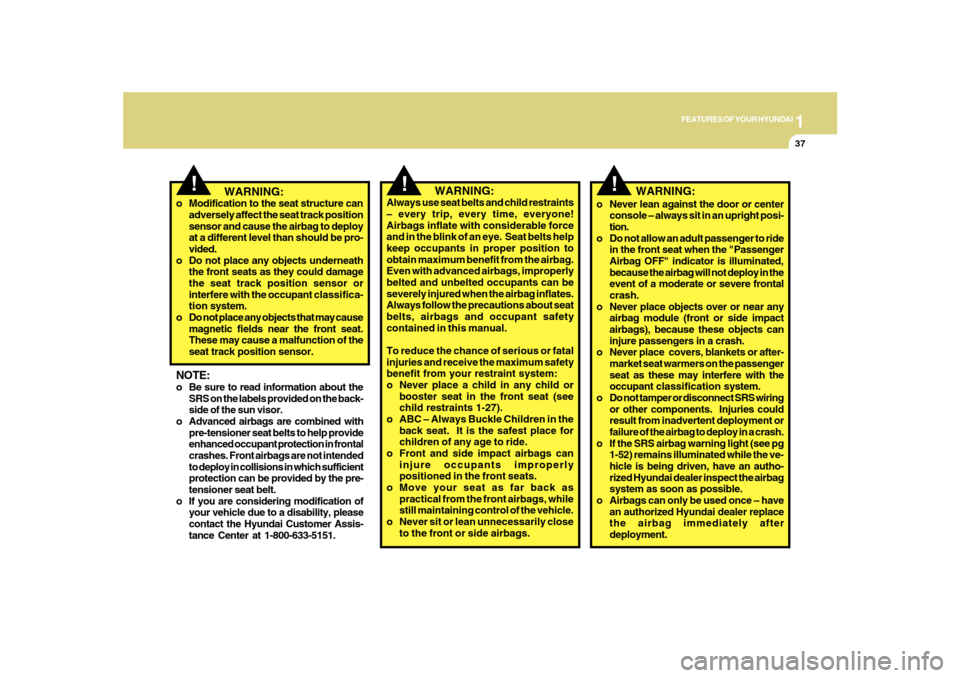
1
FEATURES OF YOUR HYUNDAI
37
!
!
WARNING:
Always use seat belts and child restraints
– every trip, every time, everyone!
Airbags inflate with considerable force
and in the blink of an eye. Seat belts help
keep occupants in proper position to
obtain maximum benefit from the airbag.
Even with advanced airbags, improperly
belted and unbelted occupants can be
severely injured when the airbag inflates.
Always follow the precautions about seat
belts, airbags and occupant safety
contained in this manual.
To reduce the chance of serious or fatal
injuries and receive the maximum safety
benefit from your restraint system:
o Never place a child in any child or
booster seat in the front seat (see
child restraints 1-27).
o ABC – Always Buckle Children in the
back seat. It is the safest place for
children of any age to ride.
o Front and side impact airbags can
injure occupants improperly
positioned in the front seats.
o Move your seat as far back as
practical from the front airbags, while
still maintaining control of the vehicle.
o Never sit or lean unnecessarily close
to the front or side airbags.
!
WARNING:
o Modification to the seat structure can
adversely affect the seat track position
sensor and cause the airbag to deploy
at a different level than should be pro-
vided.
o Do not place any objects underneath
the front seats as they could damage
the seat track position sensor or
interfere with the occupant classifica-
tion system.
o Do not place any objects that may cause
magnetic fields near the front seat.
These may cause a malfunction of the
seat track position sensor.NOTE:o Be sure to read information about the
SRS on the labels provided on the back-
side of the sun visor.
o Advanced airbags are combined with
pre-tensioner seat belts to help provide
enhanced occupant protection in frontal
crashes. Front airbags are not intended
to deploy in collisions in which sufficient
protection can be provided by the pre-
tensioner seat belt.
o If you are considering modification of
your vehicle due to a disability, please
contact the Hyundai Customer Assis-
tance Center at 1-800-633-5151.o Never lean against the door or center
console – always sit in an upright posi-
tion.
o Do not allow an adult passenger to ride
in the front seat when the "Passenger
Airbag OFF" indicator is illuminated,
because the airbag will not deploy in the
event of a moderate or severe frontal
crash.
o Never place objects over or near any
airbag module (front or side impact
airbags), because these objects can
injure passengers in a crash.
o Never place covers, blankets or after-
market seat warmers on the passenger
seat as these may interfere with the
occupant classification system.
o Do not tamper or disconnect SRS wiring
or other components. Injuries could
result from inadvertent deployment or
failure of the airbag to deploy in a crash.
o If the SRS airbag warning light (see pg
1-52) remains illuminated while the ve-
hicle is being driven, have an autho-
rized Hyundai dealer inspect the airbag
system as soon as possible.
o Airbags can only be used once – have
an authorized Hyundai dealer replace
the airbag immediately after
deployment.
WARNING: